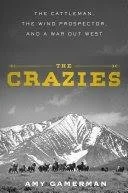REVIEW: An Extraordinary Story of Land, Money, and Energy in the New West
/The Crazies: The Cattleman, the Wind Prospector and a War Out West by Amy Gamerman (Simon & Schuster, 464 pp.|)
By Ann Fabian
There’s a note “about the author” at the end of Amy Gamerman’s remarkable book, The Crazies: The Catttleman, the Wind Prospector and a War Out West. Gamerman “has written about real estate and culture for the Wall Street Journal for more than two decades”—twin beats that have given her a perfect skill set for this meticulously reported story about a decades-long lawsuit over wind turbines in the shadows of Montana’s Crazy Mountains.
Every reader of the real estate section knows there are stories (big and small) behind every property transfer. And Gamerman does have stories to tell about real estate bought and sold, but her book is really about property and energy in the American West, stories that tangle their way through long histories of native peoples, natural resources, extractive industries, property rights, cash-poor ranchers, land-greedy billionaires and contested visions of an energy future weaned from dependence on hydrocarbons. It’s all rich grist for a cultural reporter with a canny sense, not just of the history of power that comes from coal or wind but a history of power exercised by money and moneyed men.
Gamerman begins her story in an old hot-springs hotel dreamed up and burned down in the middle years of the 19th century. But some forty-nine million years before white settlers took to soaking in mineral baths, the shifting tectonic plates that produced the mineral springs collided to produce the 30-odd jagged peaks locals call the Crazies. Sites in the Crazies have long been sacred to the Apsáalooke or Crow people, but thanks to the legacy of land divvied up to build the Northern Pacific Railroad, most of the Crazies are now private property, owned by some of the richest people in America.
Sweet Grass County, home to the Crazies, is beautiful, but it is also one of the windiest places in the country.
Reporting on Russell Gordy—a billionaire “ranch collector” who made his money in oil and gas—led Gamerman into the story of the lawsuit known as Diana’s Great Idea et al. v. Crazy Mountain Wind et al. A “modern-day range war in a warming West,” she calls it, “a ghost story haunted by generations of dreamers and strivers, those drawn to the land and those who lost it, the dispossessed, the exiles. At its heart was an old cowboy in suspenders, and the all-American spectacle of neighbors suing each other.”
Some very rich landholders launched a lawsuit to stop two local ranchers who had signed leases to build a wind farm on their land. The plaintiffs were strange bedfellows, united by little beyond their enormous wealth and “a common aversion to wind turbines.” They included oilman Gordy; Jan Engwis a wealthy rock blaster from Colorado; Whitney and Betty MacMillan, heirs to the Cargill multi-national food corporation; David Chesnoff, a Las Vegas criminal defense lawyer grown very rich defending pop stars, poker players and mobsters; and David Leuschen, a Montana-born businessman who squirreled away a fortune from private equity investments and bought a spread he named “Switchback Ranch.” They like to hunt elk and fish for cutthroat trout, heli-ski and look at the scenic views their money has bought.
Gamerman is a level-headed reporter but it’s fair to say her heart lies with the defendants—the working ranchers trying to pay off their debts and pass their land along to their children. Rick Jarrett, a fourth generation Montanan, is “the cattleman” at the center of the story. He is joined there by wives and girlfriends and his daughter Jami, by a neighbor Alfred Anderson and finally by the wind prospector, Marty Wilde. Wind developers, like Wilde, “were a sketchy bunch,” Gamerman writes, as cagey as old-time prospectors. “They operated just a little outside the bounds of sanity, living on a wing and a prayer.” For ranchers, developers and even outside investors, maybe, just maybe, a wind farm could spin air into gold. After all, this is a story about Montana, the “Treasure State,” a place where prizes can be mined from the earth even if treasure-taking is sometimes locked up in deals and regulations. Or guarded by machinations of the wealthy and powerful. The windfarm deal Gamerman follows in The Crazies turns on financing and power purchase agreements and on tax breaks and rates set by local utilities. The drama unfolds in committee rooms, courtrooms and hospital rooms, in kitchens and calving barns. But it all of it swirling around a central question: do Rick Jarrett and his rancher neighbors have the right to do what they want on their private property—as any freedom-loving Montanan might wish? Or should the wishes of the rich for unspoiled views of a scenic landscape prevail?
And what can this local contest, with all of its twists and turns, teach us about obstacles that stand in the way of the transition to a new energy economy? Gamerman’s book is long on detail and unless you pay careful attention you can sometimes lose track of her characters. But characters are the heart of her story, a way of understanding a contest that doesn’t break along predictable political lines. Everybody, not just the ranchers and the billionaires, has a name, a family and a backstory: ranch hands, county commissioners, public service commissioners, local reporters for the Big Timber Pioneer, eagle experts, a lawyer who was once an Olympic rower and Shane Doyle, the Crow activist whose children have joined the climate lawsuit against the state of Montana.
The case drags on. Wives and girlfriends come and go. Accidents kill and cripple lead characters. And when a judge grants an injunction that would delay construction beyond delivery dates promised in contracts with the local energy company, the wind farm’s outside investors pull the plug on Crazy Mountain Wind and eye another site for the windmills they’d purchased. The ranchers ink some sort of deal with billionaire Gordy and promise not to install wind turbines or nuclear power plants on their Montana land.
This might be the end of the real-estate story, but Gamerman has a scene or two left in her cultural story about power, economic inequality and the struggle to imagine a future less dependent on fossil fuels. By the last quarter of the book, she seems to have lost patience with Gordy, Leuschen and their wealthy allies and begun to adopt the language of the locals who have labeled them the “oligarchs.”
After the case had settled, she sat down with David Leuschen and told him about Rick Jarrett and his neighbor Alfred Anderson and explained what the loss of the wind farm had meant to them. Leuschen knew his billionaire neighbors, but he told Gamerman that this was the first time he had heard about the ranchers who had leased their land for the wind farm. “Too bad about the lost revenue,” he said. “I mean this is America. This is how things work. There is no villain in that.”
Gamerman’s extraordinary book is a powerful reminder that local reporters and local stories matter. Maybe there are villains in the skewed victory of the oligarchs. Reading The Crazies, it seemed to me America might be better off with more wind farms and fewer billionaires with their scenic consultants and heli-skiing friends.
Ann Fabian lives in New York and writes about books. She has spent many years studying the American West.










